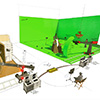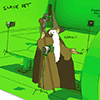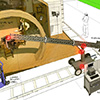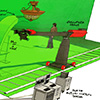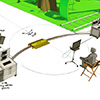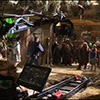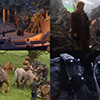The Hobbit : An Unexpected Journey
| Studio: | New Line Cinema |
| Director: | Peter Jackson |
| Equipment: | Genuflex Mk III : Scale Moco package |
| Location: | Wellington, New Zealand |
| Date: | 2010~2012 |
| Crew: | Mike Leben, Paul Maple, Chris Paxson |
Scaled Motion Control
*Images and Video Courtesy of: New Line Cinema
"How did we shrink down the actors on set in real-time?! "
In this presentation, we used an Encoded 30ft Technocrane that "drove" the Genuflex Mk III to demonstrate scaled shooting with a composite of both camera views in real-time.
Production photos
In the past, Peter Jackson, had to shoot characters of different sizes at different times, then piece the scenes together in postproduction. There was no way to direct the whole scene at once, no opportunity to finesse performances"said motion-control supervisor Alex Funke. "With this new Scale Moco system, Peter watched scenes from The Hobbit unfold in real time."
Instead of shooting the actors at different times, the director recorded them with cameras on two different sets, "Live set" and "Slave set". This allowed him to position the lens much closer to Gandalf in front of green screen, raising his stature. In the postproduction process, they could digitally remove the background and merge the two images.
We installed digital encoders on a new Aerocrane Super Jib. All encoders measured the lift and swing of the boom axes, the speed and movement of the dolly, and the degrees of pan and tilt. All the data was funneled to a motion-control system, Genuflex Mark III, with software specifically designed to scale the information down and relay instructions to the slave side.
When the Genuflex Mark III system received the instructions via its own motion-control system, its servo motors—fast, silent, and accurate—mirrored the action of Aerocrane.
"The film's video assistant system was a marvel capable not only of recording the digital feeds from all four cameras—two on each rig for 3D effect—but also of combining them into an image Jackson could review. His takes often stretched to 12,000 frames. That's close to 2 terabytes of data per shot. " Funke says.
Related site: Popular Machanics.


